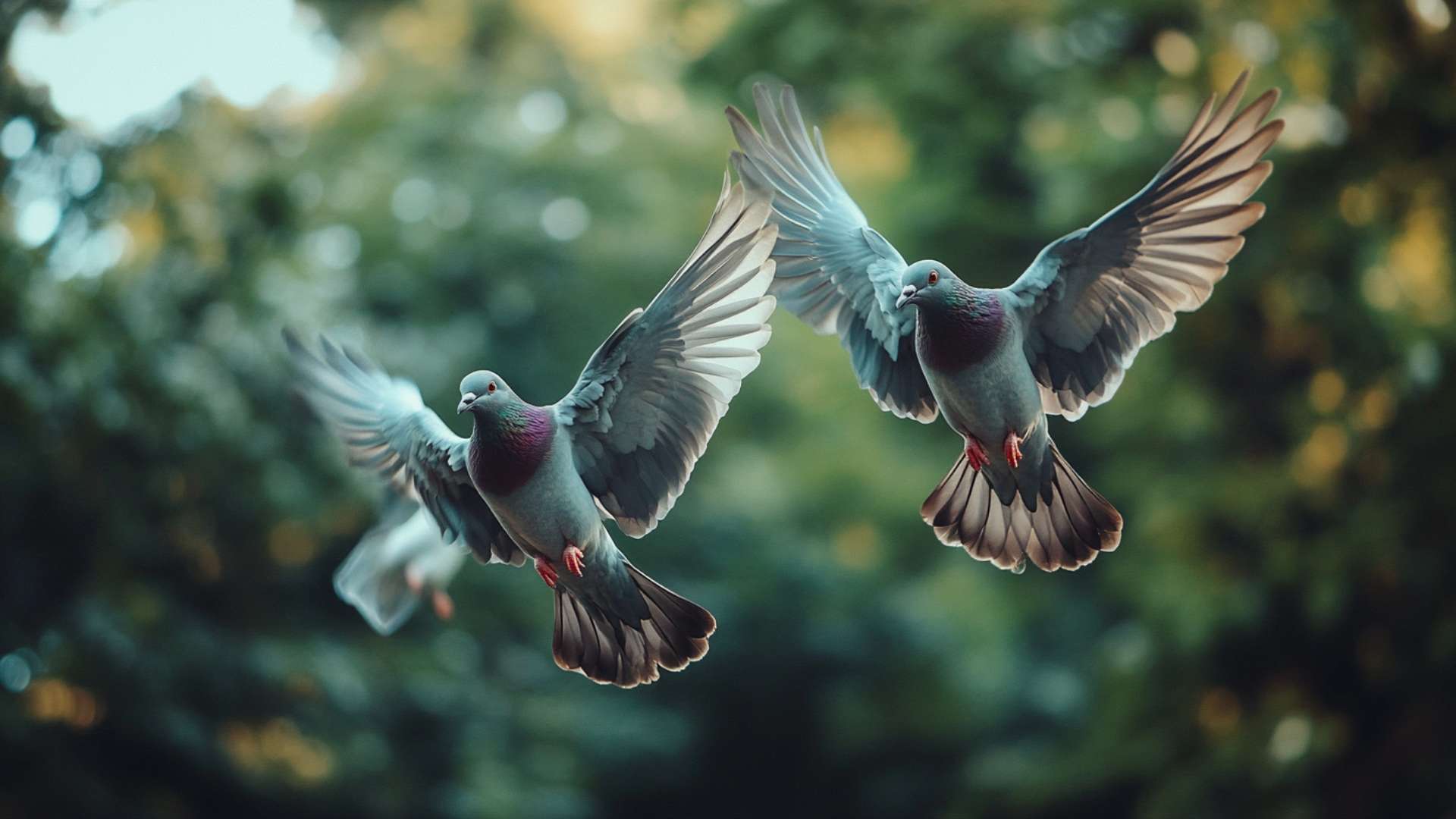Pigeons, scientifically known as Columba livia, find pigeons fascinating creatures that have captured the attention of humans for centuries. Belonging to the family Columbidae, they are a species of birds that exhibit a remarkable range of behaviors and characteristics.
Pigeons have a global presence and can be found in various habitats, ranging from high arctic regions to coastal areas. Their adaptability has allowed them to thrive in both urban and rural environments, often seen perched on building ledges or soaring through the city streets.
One of the most well-known wild pigeon species is the rock dove, which serves as the ancestor for many domesticated pigeons we see today. Wild pigeons and rock pigeons typically have bluish-gray feathers with iridescent hints and distinct wing patterns.
They possess strong wings that facilitate swift flight, enabling them to navigate their surroundings with ease. Due to their urban presence and historical association with carrying messages during war times, pigeons are often popularly referred to as “city birds” or “messenger birds.”
Discover Our Expert Pigeon Control and Extermination Solutions! Explore how our professional pigeon control and extermination services can efficiently tackle your pigeon-related issues. Click now to find out more about our specialized pigeon control and extermination services!
Importance of studying pigeon behavior and characteristics
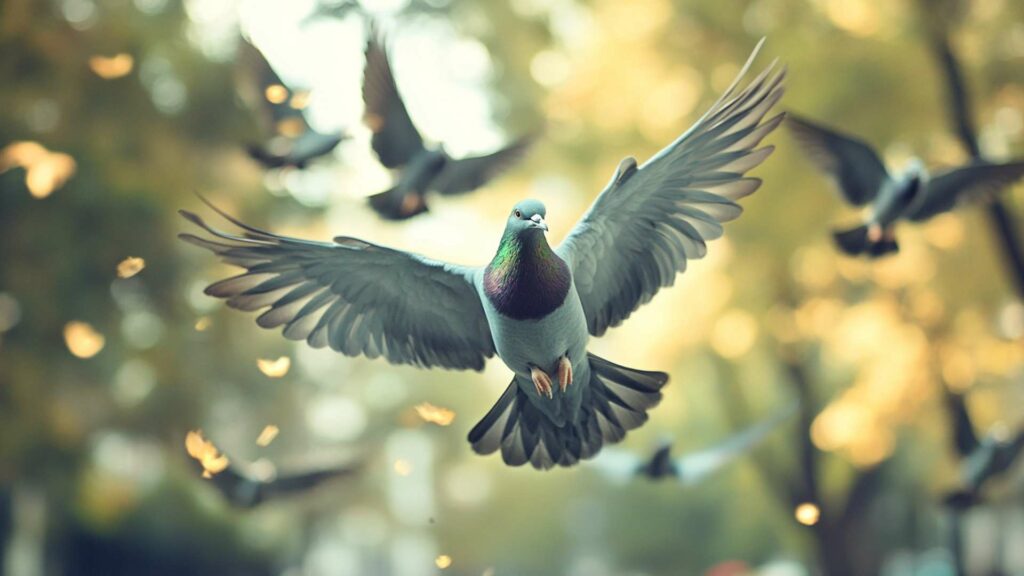
Understanding pigeon behavior and characteristics is crucial for several reasons. Firstly, studying these avian creatures provides valuable insights into general bird behavior since many behaviors exhibited by pigeons are representative of traits seen in most birds.
By investigating how pigeons interact within their social groups or build nests for breeding purposes, we gain a broader understanding of bird behavior as a whole. Additionally, pigeon research has practical applications concerning human-animal interactions.
For instance, comprehending their homing instincts could contribute to advancements in navigation technology or help improve our understanding of migration patterns in other bird species. Moreover, learning about pigeon intelligence can expand our knowledge about animal cognition more broadly.
Furthermore, studying the diet preferences and feeding habits of pigeons sheds light on ecological dynamics. Pigeons are omnivorous creatures, feeding on a wide range of food sources, including seeds, fruits, insects, and even discarded human food.
By using pigeon nests and examining their foraging behavior and interaction with human beings in urban environments, we can better understand the impact of human activities on wildlife and contribute to sustainable urban planning. Pigeons are extraordinary creatures that play a significant role in our ecosystems and hold relevance for various scientific fields.
Their unique behaviors and characteristics provide a window into avian behavior as well as broader aspects of animal cognition. As we delve deeper into the intriguing world of how pigeons live, we discover not only captivating insights about these feathered companions but also gain a greater understanding of the natural world around us.
How Long Can a Pigeon Survive Without Water?
Discover the remarkable adaptability of pigeons and their endurance in various conditions as we answer the intriguing question: How long can a pigeon survive without water? Gain insights into their survival strategies and physiological capabilities.
How Much Does a Pigeon Weigh?
Delve into the world of pigeon anatomy and avian diversity as we explore the topic of how much does a pigeon weigh? Learn about the factors influencing pigeon weight and their impressive range of sizes.
How Long Do Pet Pigeons Live?
Uncover the joys and responsibilities of having pet pigeons while addressing the question: How long do pet pigeons live? Explore the factors that influence their lifespan in a domestic environment.
How Long Do Pigeons Live?
Explore the lifespan of pigeons in their natural habitat and urban settings, answering the question: How long do pigeons live? Gain insights into the challenges they face and their remarkable adaptability.
How Fast Can a Pigeon Fly?
Take to the skies with pigeons and learn about their incredible aerial abilities as we discuss how fast can a pigeon fly. Discover the science behind their swift and efficient flight.
How Do Pigeons Mate?
Delve into the romantic lives of pigeons and explore their unique mating behaviors. We answer the question: How do pigeons mate? Gain insights into their courtship rituals and the formation of pair bonds.
How Do Pigeons Puff Up?
Uncover the secrets of pigeon behavior and communication as we discuss how do pigeons puff up? Explore the reasons behind this fascinating behavior and what it reveals about their state of mind.
How Do Pigeons Mate for Life?
Explore the concept of monogamy in the avian world and learn about the intriguing topic of how do pigeons mate for life? Discover the strong and enduring bonds formed by pigeon pairs.
How Do Pigeons Lay Eggs?
Delve into the reproductive biology of pigeons as we answer the question: How do pigeons lay eggs? Gain insights into the egg-laying process, nesting behaviors, and the nurturing of pigeon offspring.
Description of Pigeon Size, Shape, and Color Variations
Variations in Size
Pigeons come in various sizes, with the average adult pigeon measuring between 11 and 15 inches in length from beak to tail. However, there are some larger species more pigeons that can reach up to 20 inches or more.
On the other hand, smaller pigeon breeds may only measure around 7 to 9 inches. These size variations between racing pigeons can be attributed to factors such as subspecies and geographical location.
Distinctive Shapes
One of the characteristics that set pigeons apart is their unique shape. They have small heads adorned with vibrant eyes that exhibit a wide range of colors such as red, orange, yellow, or brown.
Their stout bodies are well-built and compact, allowing them to withstand various weather conditions. The body shape differs slightly among pigeon breeds – some have a more rounded appearance while others possess a slenderer profile.
Fascinating Color Varieties
The color variations among pigeons are truly remarkable. From the classic grayish-blue hues commonly associated with pigeons – reminiscent of their wild ancestor, the rock dove – to a plethora of other shades such as white, black, brown, and even piebald patterns (patches of two or more colors), these birds display an impressive palette.
Furthermore, some pigeons exhibit iridescent feathers that shimmer when hit by direct sunlight. These feathers may appear in shades of green or purple depending on the angle at which light strikes them — a stunning visual display for any bird enthusiast.
Unique Features: Small Heads, Stout Bodies, and Strong Wings
Small Heads with Prominent Beaks
Pigeons possess relatively small heads compared to their body size. Their beaks are distinctively shaped like stout cones, which aid in their feeding habits. The beak’s tip is hooked to facilitate grasping and manipulating food, while the inside is equipped with a fleshy structure known as the “cere,” responsible for their sense of touch.
Stout Bodies Built for Flight
Pigeons have stout bodies that are highly adapted for efficient flight. Their strong pectoral muscles power their wings, allowing them to navigate through the skies gracefully. Pigeons’ skeletal structure is lightweight yet robust, ensuring they can withstand the demands of long-distance flights or quick aerial maneuvers.
Powerful Wings
Pigeons possess remarkable wing strength, enabling them to achieve impressive speeds and cover considerable distances during flight. Their wingspan varies depending on the species but typically ranges from 20 to 26 inches.
This expansive wingspan allows pigeons to effortlessly glide through the air currents as they seek out food sources or return to their nests. In addition to their ability to fly swiftly and skilfully, pigeons also have precise control over their wing movements.
This agility allows them to perform intricate aerial displays during courtship rituals or when evading predators. Watching these magnificent birds maneuver through the sky is a sight that never fails to captivate observers.
Whether spotted in urban areas flocking together with other pigeons or admired by dedicated pigeon keepers who treasure each bird’s unique beauty, pigeons continue to fascinate us with their physical characteristics that make them stand out among most birds. So next time you encounter a pigeon perched on a city rooftop or see a group of them soaring overhead in large flocks leave the nest, take a moment to appreciate these remarkable creatures and marvel at nature’s diversity within the Columbidae family.
Pigeon Intelligence and Communication
Discussion on the intelligence levels of pigeons
When it comes to pigeon intelligence, these birds are surprisingly sharp. They possess the ability to recognize faces and objects, which is quite remarkable for a non-mammal species. In fact, studies have shown that pigeons can identify and remember human faces with a high level of accuracy.
This cognitive skill for baby pigeons allows them to distinguish between familiar and unfamiliar individuals in their surroundings. Furthermore, adult pigeons also have been found to exhibit astonishing problem-solving skills.
In experiments conducted by researchers, these birds demonstrated an impressive ability to navigate complex mazes, solve puzzles involving levers or buttons, and even comprehend numerical concepts like counting. Their aptitude for problem-solving indicates a higher level of cognitive abilities that may be underestimated by many.
Communication methods among pigeons
Pigeons have developed various communication methods to convey messages within their flock or during courtship displays. These methods involve both vocalizations and body language. In terms of vocalizations, the most commonly recognized sound made by pigeons is their gentle cooing.
This soft warbling sound echoes through city streets as well as nature reserves where these birds are commonly found. Additionally, pigeons communicate through bill-clapping sounds, which is produced when they rapidly tap their beaks together.
Such vocalizations serve as important signals during interactions between individuals. Apart from vocal cues, pigeons also employ distinct body language for communication purposes.
Head bobbing is one such behavior where pigeons rhythmically move their heads up and down in quick succession. This motion often indicates attentiveness or alertness towards the outside world or other birds nearby.
Pigeons also puff up their feathers when they want to appear larger or more threatening to potential rivals or predators. Another common display is wing spreading, which is often seen during courtship rituals as a means to attract a potential to mate for life together.
Overall, through a combination of vocalizations and body language, pigeons effectively communicate with their flock members, establish dominance hierarchies, and convey their intentions during courtship or territorial disputes. Their ability to express themselves non-verbally plays a crucial role in maintaining social harmony within their communities.
Pigeons possess remarkable intelligence levels considering their perceived reputation as mere city-dwelling birds. Their ability to recognize faces and objects showcases an advanced cognitive capacity beyond what one would typically associate with avian species.
Moreover, the problem-solving skills they exhibit highlight their adaptability in various environments. When it comes to communication, pigeons employ an array of vocalizations such as cooing and bill-clapping sounds, along with body language like head bobbing and wing displays.
These communication methods allow them to navigate social interactions efficiently and convey important messages within their flock or during courtship rituals. Clearly, there is more than meets the eye when it comes to these feathered creatures.
Pigeon Social Structure and Behavior
Formation of Pair Bonds Between Males and Females
Sublime Courtship: Bowing, Cooing Displays, and Billing When it comes to romance, pigeons are no slouches.
The male pigeon strives to win the heart of its potential mate through a series of charming courtship rituals. Picture this: a suave male pigeon gracefully bows its head towards the female, showing off its exquisite plumage as if it were wearing a tuxedo.
Meanwhile, it serenades her with a melodious coo that could make any heart flutter. This courtship repertoire doesn’t end there!
The male pigeon may even engage in an act known as “billing,” where he gently taps his beak against the female’s beak in an affectionate gesture. These enchanting displays serve as a way for pigeons to communicate their intentions and strengthen their bond.
Lifelong Monogamy: The Pigeon’s Love Story. Once the courting dance between pet pigeons is complete and mutual attraction has been established, female pigeons can demonstrate incredible loyalty by forming lifelong monogamous pairs.
Unlike other animals where promiscuity runs rampant, pigeons are committed partners until death do them part. This unwavering loyalty between male and female pigeon mates is one of the reasons why pigeons have captivated the hearts of humans throughout history.
Flock Behavior Among Pigeons
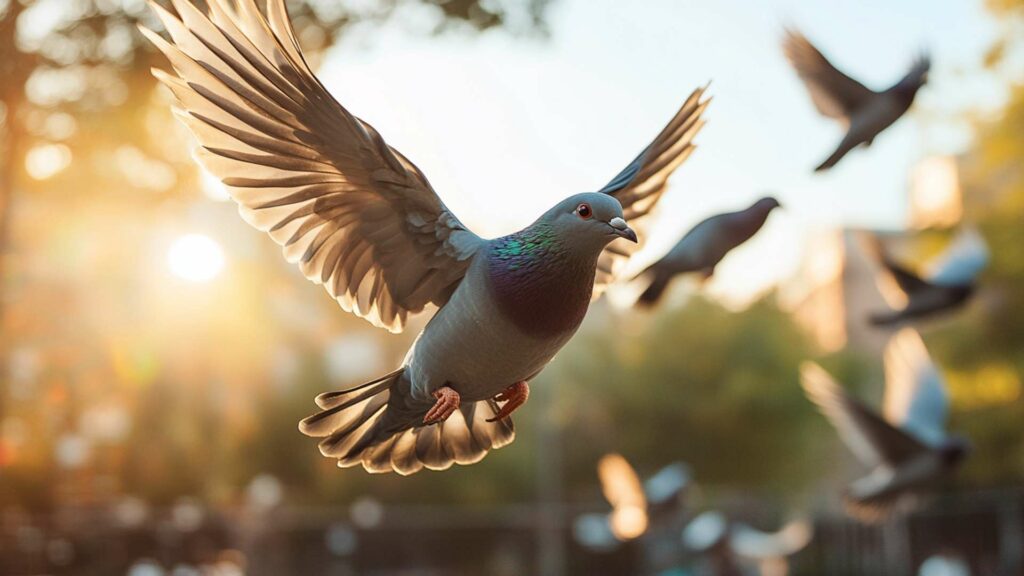
The Hierarchy Within Flocks: A Pecking Order Within flocks of pigeons, dominance reigns supreme.
Just like in many other bird species, there exists a hierarchical structure that determines each individual’s place in the pecking order (pun intended). Dominant birds assert their authority by puffing up their tail feathers, and engaging in territorial displays while submissive birds respectfully yield to their higher-ranked counterparts.
This social structure helps regulate interactions within the flock and maintain order during activities such as feeding or roosting. Unity in Flight: Synchronized Patterns
Pigeons are known for their mesmerizing flights, where flocks move as one entity, seemingly choreographed in the sky. This collective behavior of racing pigeons is not only stunning to observe but also serves a practical purpose—safety in numbers.
By flying together in synchronized patterns, pigeons reduce their vulnerability to predators and increase their chances of finding enough food. This coordinated group movement demonstrates the remarkable cohesion and communication skills that pigeons possess.
Family Matters: Group Activities Pigeons are social creatures that enjoy spending time with their extended avian family members.
Whether it’s sharing a meal or engaging in playful flights, group activities play an important role in reinforcing bonds within pigeon communities. Flocks of pigeons can often be found feeding together, taking turns to ensure everyone gets a fair share of nourishment.
Moreover, young pigeons learn essential life skills from observing older individuals within their mother pigeon flock, fostering a sense of unity and cooperation among them. Pigeon Power Dynamics: Dominance and Cooperation
In this dynamic world of winged wonders, the hierarchical structure within pigeon flocks ensures order while fostering cooperation among members. Dominant birds have preferential access to resources such as food and nesting sites while less dominant individuals abide by these unwritten rules without conflict.
This delicate balance allows pigeons to thrive collectively while minimizing unnecessary aggression often observed in other bird species. From courtship rituals that could melt even the coldest hearts to organized flocks soaring through the skies with breathtaking precision, pigeon behavior is truly captivating.
Their lifelong monogamy and cooperative nature make them a model for strong partnerships and harmonious social dynamics. As we continue our exploration into the fascinating world of pigeons, let’s now turn our attention towards another extraordinary aspect of their existence—their homing instincts and remarkable navigation abilities that allow them to traverse vast distances with unerring accuracy.
Homing Instincts and Navigation Abilities in Pigeons
Explanation of Homing Instinct – their ability to find their way back home over long distances
Pigeons have a remarkable homing instinct, which allows them to navigate and return to their homes over vast distances. This innate ability has been studied for centuries, and although the exact mechanisms are not fully understood, scientists believe it involves a combination of factors.
Homing pigeons, which are domestic pigeons bred for their navigational abilities, have been extensively used in pigeon racing competitions and as messengers throughout history. One theory behind the homing instinct suggests that pigeons use a combination of visual cues and mental maps to determine their way back home.
They rely on landmarks such as buildings, mountains, or bodies of water to guide them along their route. Studies have shown that even if they are transported hundreds of miles away from where they were released, pigeons can still find their way home by recognizing these familiar visual cues.
Factors Influencing Navigation Abilities
1. Use of Visual Landmarks: Pigeons have excellent visual memory and can recognize landmarks from above. They create mental maps by memorizing specific features in the landscape during previous flights. This enables them to navigate efficiently even when they encounter unfamiliar areas.
2. Sensitivity to Earth’s Magnetic Field: Another factor influencing pigeon navigation is their ability to sense the Earth’s magnetic field. Pigeons possess magnetoreceptors in their beaks, which help them detect slight variations in the magnetic field lines. This allows them to orient themselves in relation to north-south axis lines and maintain a consistent heading towards home.
3. Ability to Memorize Routes through Repeated Flights: Practice makes perfect for pigeons when it comes to navigation. Through repeated flights, pigeons become familiar with specific routes, memorizing landmarks and adjusting their flight paths accordingly. By gradually building up their spatial knowledge, pigeons can navigate more efficiently over time.
It is important to note that the homing instinct and navigation abilities vary among different pigeon populations. While domestic pigeons bred for racing or messenger purposes exhibit strong homing instincts, wild birds may not possess the same level of navigational prowess.
Additionally, feral pigeons (commonly seen in urban areas) primarily rely on local landmarks rather than long-distance navigation. The homing ability of feral pigeons live is a fascinating aspect of their behavior.
Through a combination of visual cues, magnetic field sensitivity, and route memorization, these birds demonstrate remarkable skills in finding their way home over long distances. Their navigational prowess has captivated humans for centuries and continues to intrigue researchers as they uncover more about the intricate mechanisms behind this remarkable phenomenon.
Feeding Habits and Diet Preferences of Pigeons
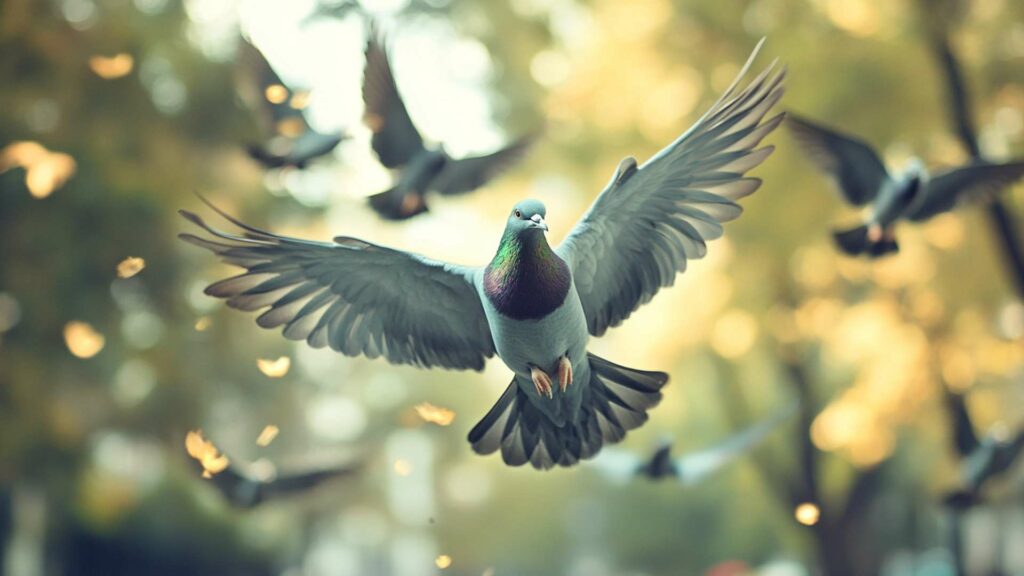
The Omnivorous Nature of Pigeons
Pigeons, being opportunistic feeders, have a remarkably adaptable diet that allows them to thrive in various environments. Their natural omnivorous tendencies enable them to consume a wide range of food sources.
While they primarily rely on grains and seeds as their main food source, pigeons are not picky eaters. They often scavenge for scraps in urban areas, consuming anything from bread crumbs and discarded fast food to fruits and vegetables left behind by humans.
Grains and Seeds: Dietary Staples
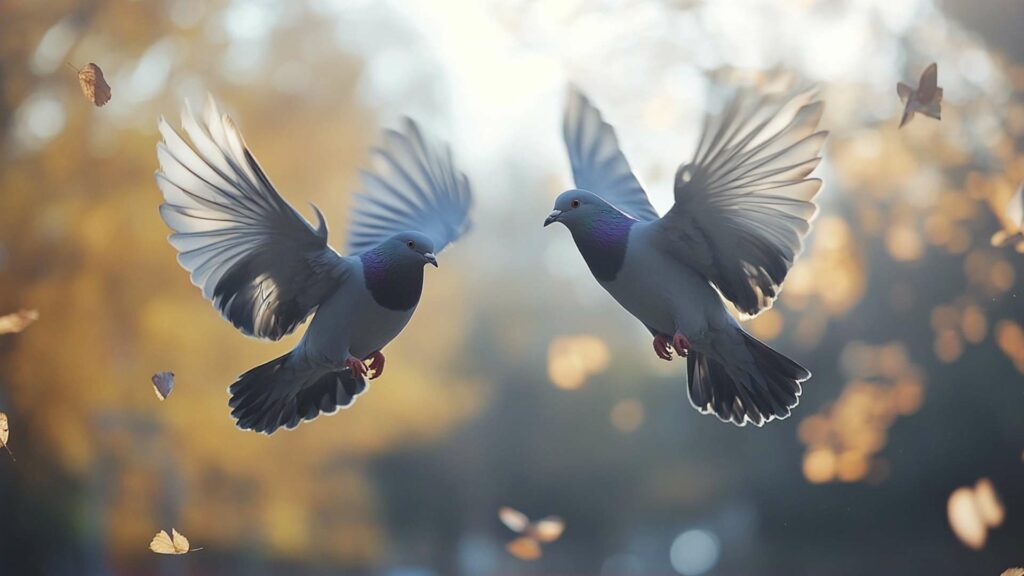
Grains and seeds are the foundation of a pigeon’s diet. They go crazy for options like barley, corn, wheat, peas, sunflower seeds, and millet.
These provide the necessary carbohydrates pet pigeon has for energy to sustain their active lifestyle. Pigeons have even developed a unique way of swallowing seeds whole by pinching them between their upper and lower beaks while tilting their heads backward.
A Protein Boost: Insects and Small Invertebrates
To supplement their diet with essential proteins, pigeons occasionally devour insects such as beetles, caterpillars, snails, spiders, and even earthworms. Spotting pigeons pecking at the ground is not unusual; they might be feasting on tiny invertebrates hidden beneath the surface.
Foraging in Urban Areas
In urban environments where traditional food sources might be limited, pigeons showcase remarkable adaptability by seeking out alternative options such as discarded human food or leftovers from outdoor dining areas. This scavenging behavior demonstrates their ability to find sustenance even in challenging conditions.
Pigeon Feeding Etiquette: What Not to Feed Them
While it might be tempting to feed pigeons when encountering them in parks or squares, it is essential to exercise caution. Certain foods can be harmful to their health and disrupt their natural feeding habits. Avoid feeding pigeons processed foods, salty snacks, dairy products, or anything that could potentially harm them.
Conclusion
The dietary preferences and adaptability of pigeons are truly remarkable. From grains and seeds to insects and even discarded human food, these birds have perfected the art of survival through their omnivorous nature. Pigeons remind us that despite the challenges they face in urban environments and changing landscapes, they have found creative solutions to find sustenance.
Their ability to adapt serves as a reminder that nature has its ways of thriving even amidst adversity. So next time you encounter a pigeon on your city stroll, take a moment to appreciate their resourcefulness and resilience in navigating the concrete jungles we call home.
Frequently Asked Questions:
Pigeons exhibit behaviors like cooing, perching, and foraging.
Pigeons are social birds, often seen in flocks and pairs.
Five characteristics of pigeons include strong homing abilities, gentle disposition, adaptability, cooing vocalizations, and distinctive plumage.
Aggressive pigeon behavior can involve pecking, territorial disputes, and competition for resources.

